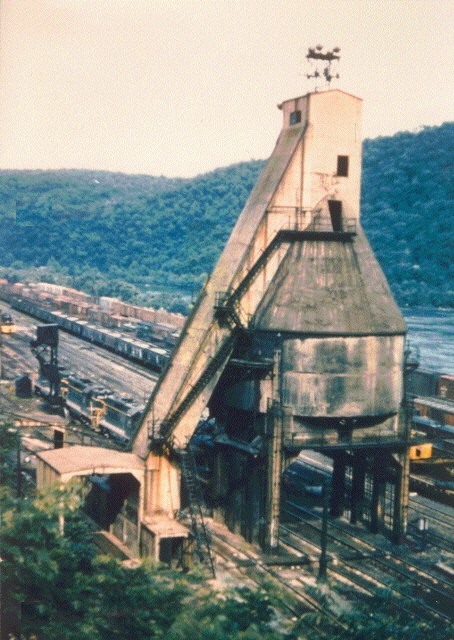|
STEAM
OPERATIONS OF THE CHESAPEAKE
& OHIO RAILWAY AT by William E.
Simonton, III |
|
|
| Home | Steam Operations | Drawings | QN
Cabin | Typical Heavyweight
Passenger Car Consists 1940's | Contact
| |
Photo courtesy Steve Trail - Photo has Hotspots |
The Chesapeake & Ohio Railway yard and shops at
Several years ago the Chesapeake & Ohio Historical
Society, Inc. changed web providers.† As
one result the Drawings Page hyperlinks were scrambled.† My old html editing software was obsolete as
was my Word software and correcting the errors was secondary as I was working
on the rebuild of Climax CN 1551 at Cass, West Virginia, and preparing 3D CADD
drawings of that locomotive.† I have now corrected
most of the hyperlink errors but some remain a work in progress (Notes particularly)
as does the appearance of the Drawings Page and a few other Page errors.† I will continue to work to correct the remaining
hyperlinks and the appearance.† (1-7-2021)
WHY HINTON?
A model railroader for thirty-five years and a Chesapeake & Ohio Railway modeler since 1973, I became interested in Hinton after doing some research to determine what real location on the C & O offered a steam era terminal, grades and tunnels which make putting more railroad in the limited space available for modeling "easier".† I began researching Hinton after deciding that the location provided a ideal prototype for a steam era terminal from which to run C & O H-7 2-8-8-2's -- my favorite C & O steam.† The run to the summit of the Alleghany Subdivision provides numerous tunnels including Big Bend Tunnel just east of Hinton where the legendary John Henry contested an early steam drill and steady grades which are ideal. The C & O track was laid through west end of Big Bend Tunnel September 12, 1872, and and the tracks reached to the east end of what became the Hinton's Avis Yard on September 25, 1872. The after discovered fact that Hinton was a division point between the New River Subdivision and the Alleghany Subdivision where all through freight and passenger power were changed validated my decision.† I decided to start with the terminal and model in reduced form as much of the railroad to Alleghany, Virginia as time, space and money would permit with a single track main line and passing sidings to save space.† I also had to determine what trains passed through or originated at Hinton so that I can approximate the prototypical mix, and re-create a steam locomotive terminal that was all but gone when I began my research about 1978.† Originally, my interest was just to gather sufficient information to build models of the roundhouse and coal dock.† Those two structures and some yard tracks were to be Hinton.† It did not turn out that way.† The research required on Hinton has become my hobby while I model some structures.
My research and that of Jim EuDaly who has the track in his Hinton yards almost complete on his O scale layout determined that Hinton originated twelve eastbound coal drags each day powered by two H-7's in the early 1940's and two H-8 Allegheny 2-6-6-6's in the late 1940's -- one on the head end and a pusher.† An equal number of westbound empties arrived.† Manifests used H-7's or H-8's and passenger trains used 4-8-4's, 4-8-2's and occasionally an H-8 on the Alleghany Subdivision, and 2-8-4's, 4-6-4's and 4-6-2's respectively on the New River Subdivision.† Double heading passenger trains was common over the hill.† Four 0-8-0 or 0-10-0 switchers worked each trick at the Hinton yards, and 2-8-0's, 2-8-2's and 2-6-6-2's were used on local freights on the New and Alleghany Subdivisions.† Although no mine shifters worked out of Hinton, 2-6-6-2's were used to haul coal on the Greenbriar Sub to its interchange with the Western Maryland at Durbin, and handled coal off the Meadow River from Rainelle. As a result of all the activity, 70 to 100 steam locomotives were serviced in the "pit" as the locomotive service area at Hinton was known every 24 hours.† This would keep anyone's Friday night model railroading group busy.
In addition to changing locomotives and originating local passenger,
local freights and coal drags, one also have to live with the constraints of
using steam power.† For every hour spent
on the road, a steam locomotive typically needed an hour or more of maintenance
or servicing.†††
††††††††††† †If you run
steam or plan to all the service, maintenance and time must be taken into
account when running the railroad.† There
was no such thing as a quick turn-a-round for steam.† The maintenance of a railroad's steam
locomotive fleet was an industry in and of itself and that is what I hope to
recreate.† When first generation diesels
came to Hinton they required an inspection every 24 hours, and if they could
make a run before their clock ran they were sent back on the road without
inspection.† It is very easy to see why
diesels replaced steam in a three-to-one or sometimes four-to-one ratio, but it
took until recently for single diesels to approach the more than 6000
horsepower that a single H-8 provided.
†††††††††††
†††††††††††
†††††††††††
Please
feel free to email me using the email address on the Contact page.
Last Updated: 1/7/2021
[1]† Although the mountains are the Allegheny, the C & O
subdivision is the Alleghany Subdivision with the summit at Alleghany,
Virginia, and the eastern terminus Clifton Forge, Virginia.
